Cavitation is a very common problem for pumps. If you hear strange noises coming from your pump, there is a good chance that cavitation is the reason. But what exactly are the causes and effects of cavitation? And what preventive actions we can take to overcome the cavitation? Read it out to get the answers.
Table of Contents
What is Cavitation?
In a simple definition, cavitation is the formation of bubbles or cavities in a liquid, when the static pressure inside the suction line becomes less than the vapor pressure of that flowing fluid.
In other words, Cavitation usually occurs when a liquid is subjected to prompt changes of pressure that cause the development of cavities in the liquid where the pressure is relatively low.
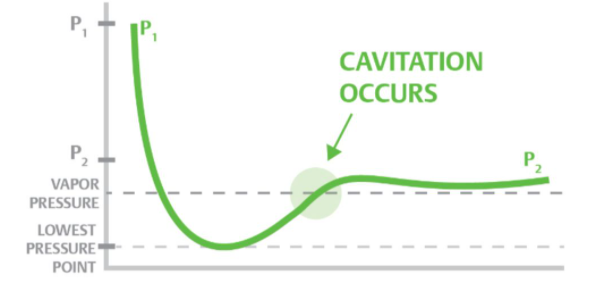
The generated bubbles further implode or collapse and it creates shockwaves inside the pipe and pump. These shockwaves cause significant damages to the pipe, impeller, and the pump housing. The bubbles formed by cavitation are much smaller and more powerful than bubbles generated by normal boiling. It is so powerful that it sounds like small stones are flowing with fluids.
It is recommended that suction line pressure should be less than atmospheric pressure but not less than the vapor pressure of the suction or flowing fluid.
NPSH (Net Pressure Suction Head) is decided by keeping in mind the above condition.
What do you mean by Vapor Pressure?
Vapor pressure is described as the pressure at which liquid molecules convert into vapor at a specific combination of pressure and temperature. The vapor pressure is different for different liquids. The best example is a pot of water on the kitchen stove.

When the water temperature reaches 100° Celsius, atmospheric pressure bubbles form on the bottom of the pot, and steam or vapor rises up. It happened because the water in the pot reaches its vapor pressure and temperature. Please note that the vapor pressure for all liquids varies with temperature as per the liquid nature.
Levels of Cavitation
According AWWS (American Water Works Association), the level of cavitation is classified in three types:
- Incipient cavitation: It represents the beginning stage of cavitation where light popping noises are heard and it can be avoided.
- Constant cavitation: It is a steady rumbling sound associated with the start of possible damage. Preventive action can be taken to avoid the damages.
- Choked cavitation: It is the point where the vaporization of the fluid reaches sonic velocity and significantly damage the pump.
Effects of Cavitation
Cavitation sounds like marbles or stone circulating inside the pump, pipes, or hoses. The effects of prolonged cavitation can be seen on the pipe, pump impeller, pump housing, and other components.
Typical symptoms of cavitation are as follows:
- The noise inside the pipe or pump
- Excessive vibration of the pipe or pump
- Pump seal or bearing failure
- Pump Impeller erosion
- Power consumption is higher than the usual
- Decreased flow or pressure compared to rated data
- Damages in the pipe
- Damages in the housing wall

Causes of Cavitation
Following points can be the causes for cavitation:
- Excessively long suction piping
- Incorrect reducer selection
- Straight pipe length is less
- Higher fluid viscosity
- Clogged strainers and filter
- Flow restriction
- Wrong pump selection
- NPSH is less than required
- Poor piping design
- Pocket in the suction line
- Pump location
Preventive Actions for Cavitation
The following preventive actions can be taken to avoid the cavitation:
1. Pump Selection
The best way to prevent cavitation is to choose the correct pump for the application. Cavitation increases as the pump head (NPSH) falls or as capacity raises. so selecting the right pump to maintain a positive margin between NPSH available and NPSH required is the first move towards cavitation prevention.
When buying new pumps, always consider the pump design and question whether it meets the Net Positive Suction Head (NPSH) requirements.
2. Discharge Cavitation
Discharge cavitation takes place if the pressure at the discharge end of the pump is too high. High discharge pressure restricts the volume of fluid flowing out of the pump, and it causes recirculation of the fluid in the pump housing, this action creates cavitation.
To avoid discharge cavitation we can consider the below points:
- If needed, we can install a control valve in the discharge line to maintain the desired pressure.
- Never put the control valve at the suction side, as it can cause more cavitation.
- The component at the discharge side should be installed in a manner that there should not be an air-trap.
- Try to Keep the reducer close to the pump.
- Avoid pockets in the discharge line.
- The valve at the discharge side should be completely open.
- Clean the filter, as there may be an accumulation of debris.
- Ensure that the check valve is installed correctly, often it is installed reversely by mistake.
3. Pump Location
The pump should be installed at the location so that the liquid flows into the suction line smoothly. Make sure that the suction lines leading to the inlet nozzle of the pump are routed in a manner so it can be benefited from the gravity. It means pump elevation should be lower than the liquid level of the supply tank, which prevents cavitation.
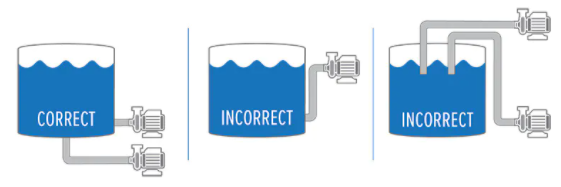
4. Suction Pipe Size and Length
Generally, the suction pipe size is taken one or two sizes greater than the pump’s suction nozzle size. Please note that the suction line can not be smaller than the pump inlet nozzle.
Therefore, the suction line requires a reducer before the pump suction or inlet nozzle to merge the size differences. As per the fluid nature, we need to select the reducer type. In most of the cases, we required to use the flat side up (FLU) eccentric reducer to avoid the air trap in the reducer body.
But, if the fluid is slurry then wen need to use a concentric reducer for smooth flow of fluid. Flat side down (FSD) eccentric reducer is used in the suction line if the fluid is in gaseous or vapor form which allows condensed fluid to drain at low points.
To maintain laminar flow, straight suction pipe length should be a minimum 3 to 5 times the diameter of the inlet nozzle of the pump. The length of the reducer can be included in the straight pipe length. Do not include elbow, strainer, flange, or valve within the straight length.
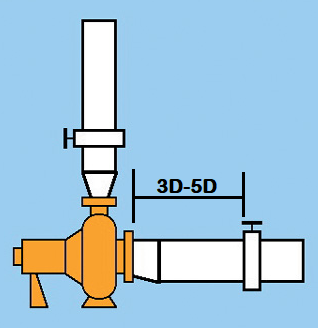
5. Friction Loss
As the fluids pass through a pipe, the friction between the fluid and the inside surface of the pipe creates turbulence, which slows down the fluid flow and effects in a pressure drop. Pipe length, diameter, and fluid flow rate all influence friction loss.
Good suction and discharge piping layouts prevent cavitation by maintaining a constant velocity throughout the line. Obstacles in the piping layouts lead to cavitation.
Pump piping layout Standard practices
- Suction piping should not be too long.
- Straight pipe length should be a minimum 3D to 5D between the pump suction nozzle and the first elbow or any other piping component other than the reducer.
- The straight pipe length provides uniform flow to the suction inlet of the pump.
- Try to keep reducers close to the pump.
- Use eccentric reducers, flat side up (FSU), to avoid the air trap.
- Always use the long radius elbow in the pump piping.
- Pump elevation should be lower than the fluid level of the supply tank.
It’s never too late for taking preventive action than to replace the pump completely. Do not ever ignore the first level of cavitation, take action at earliest, save cost, safe respect, and please make aware of the people around. Keep learning, keep sharing!!!
You may also like to read
Reinforcement Pad Calculation for Branch Connection
Pipe Wall Thickness Calculation For External Pressure or Vacuum
Miter Elbow or Miter Bend Design Calculations
How to Prepare the Pressure Temperature Rating Table for Piping System?
References
Piping Hand Book by Mohinder L. Nayyar, P.E.
Cavitation and Bubble Dynamics by Christopher Earls Brennen
www.wwdmag.com
www.csidesigns.com
blog.craneengineering.net
www.globalpumps.com.au
AWWA (American Water Works Association)-2008

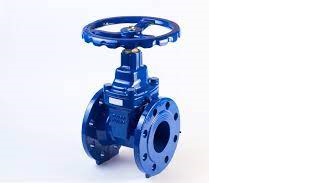

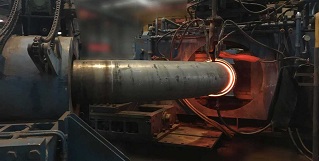
Good way of explaining, and fastidious post to get data on the topic of
my presentation subject, which i am going to present in institution of higher
education.